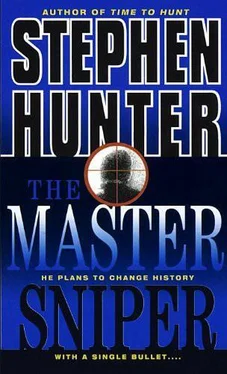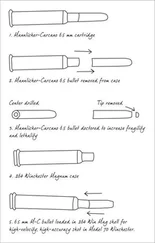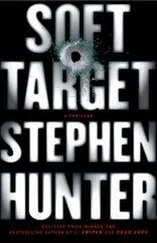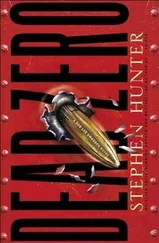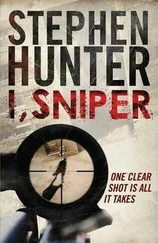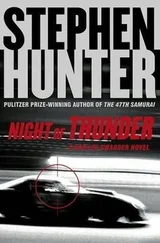Leets entered to find himself in a low dark room lined with workbenches. Injured American weapons lay in parts around the place, a brace of .30-caliber air-cooled perforated jacket sleeves, several BAR receivers, Garand ejector rods, Thompson sling swivels, carbine bolts, even a new grease gun or two. Two privates struggled to dismantle a .50-caliber on a tripod, no easy task, and in the back another fellow, a T-5, hunched over a small piece, grinding it with a file.
Leets, ignored, finally said, “Pardon,” and eventually the tech looked up.
“Sir?”
“The CO around?”
“Caught some junk last week. Back in the States by now. I’m pulling the strings for now. Sir.”
“I see,” said Leets. “You any good on the German stuff?”
“Meaning, Can I get you a Luger? The answer is, Can you get me thirty-five bucks?”
“No, meaning, What’s this?”
He held out the mashed slug.
“Outta you, sir?” asked the tech.
“No. Out of a kid up on the line.”
“Okay. That’s that new machine carbine they’ve got, the forty-four model. You catch SS boys with ’em, right?”
“Right.”
“Seven point nine-two millimeter kurz . Short. Like our carbine round.”
He took it from Leets and held it close.
“All right,” he said. “A hundred for the forty-four, five bucks apiece for any spare magazines you can get me.”
Oh, Christ, Leets thought.
“One fifty,” the tech upped his bid, “provided it’s in good condition, operational, no bad dents or bends. You get me one with the barrel-deflection device, the Krummlauf, and I’ll jump to two bills. That’s top dollar.”
“No, no,” said Leets, patiently, “all I’m interested in is this slug.”
“That’s not worth a goddamned penny, sir,” said the sergeant, offended.
“Information, not dollars, goddamn it!”
“Jesus, I’m only talking business,” said the sergeant. “I thought you was a client, is all, sir.”
“Okay, okay. Just look at the fucking bullet and tell me about it.”
“Frank, c’mere, willya? Frank’s our expert.”
Frank untangled himself from the struggle with the .50 and loped over. Leets saw that if the tech was the business brain, Frank was the esthete. He had the intellectual’s look of scorn; this was too low for him, he was surrounded by fools, more worthy ways of spending one’s life could certainly be found.
He picked the piece up, looked at it quickly.
“Let’s weigh it,” he said. He took it over to the bench and balanced it on the pan of a microscale, fussed with the balances and finally announced, “My, my, ain’t we got fun.” He rummaged around on the bench and produced a greasy pamphlet, pale green, that read “ORDANCE SPECIFICATIONS AXIS POWERS ETO 1944” and pawed through it.
“Yes, sir,” he finally said, “usually goes one hundred and twenty grains, gilding metal over a soft steel jacket. Inside this jacket is a lead sleeve surrounding a steel core. A newer type of powder is used. But this here mother weighs in at one forty-three grains. And there ain’t no steel in it at all. Too soft. Just plain old lead. Now that’s no good against things . Won’t penetrate, just splatter. But into something soft, meaning people, you got maximum damage.”
“Why would they build a bullet out of pure lead in wonderful modern 1945?” Leets asked.
“If you’re putting this wad through a barrel with real deep grooves, real biters, you can get a hell of a lot of revs, even on something moving slow. Which means—”
“Accuracy?”
“Yes, sir. The guy on the gun can put them on fucking dimes from way out if he knows what he’s doing. Even if the bullet’s moving real slow, no velocity at all. The revs hold her on, not the speed.”
“So it’s moving under seven hundred feet per second? That’s slow, slower than our forty-five.”
“Right. And at seven hundred fps or less, you’re under the sound barrier.”
“No pop. It’s better than a silencer, isn’t it?” Leets wanted to know.
“Yes, sir. Because any baffle system cuts down on feet per second, so you get a drop off in accuracy and range. Someone real smart figured all this out. I’ve never seen anything like it.”
So that’s how they did it, Leets thought.
“Hey, Captain, you get a line on this gun, you let me know,” said the tech. “It sounds nice. I’d go a thousand for it.”
When they got back to Ryan’s shop to wait for the plane that would take them back to London, the major asked an innocent question.
“Hey,” he said, “by the way, what’s Anlage Elf?”
That got Leets’s attention. He yanked up, staring hard, feeling the breath sucked from him.
“Your CO,” said Ryan, baffled by the intense reaction, “he bumped a high-priority telex through. It’s just down from Division.”
“CO?” said Leets.
“Colonel Evans.”
That son of a—
“He wants you back fastest. He says he found Anlage Elf.”
PART TWO

Gesamtlösung
(General Solution)
April–May 1945
Repp had a special request.
“Now, Herr Ingenieur-Doktor, if all goes well,” he said one morning, “all your inventions will work wonderfully. It’ll be like the tests, the targets out front, I’m shooting from a clear lane, protected. Eh? But suppose things get a little mixed up?”
“I’m not sure I—”
“Well, old friend, it’s possible”—Repp was smiling—“there’ll be some boys interested in stopping me. I might find myself in a ruckus with them, a close-in thing. Have you ever been in a fire fight?”
“No. Of course not,” said Vollmerhausen.
Again Repp smiled. “The weapon you’ve given me is superb for distance and dark. But fire fights take place where you can see the other fellow’s dental work, tell if he’s still got milk on his tongue from breakfast.”
Vollmerhausen saw immediately what Repp was driving at. Repp, equipped as no man ever had been for the special requirements of the mission, was in a more conventional engagement as good as unarmed. The heavy scope, with its cathode tube, energy converter and infrared light blocked out his view of the standard iron battle-sights.
“I can hit a germ at four hundred meters,” Repp said, “at midnight. Yet a man with a fowling piece has the advantage at fifty meters. Can you help me out? I’d hate to have all this end up in disappointment because of some accident.”
Vollmerhausen puzzled over the problem, and soon concluded that he could spot-weld still another piece, a tube or something, under Vampir, to serve crudely as a sight. It wouldn’t be on the weapon’s axis, however, but rather parallel to it, and thus it would have to be adjusted in its placement to account for this difference. He chose the carrying case of a K-43 scope, a nicely milled bit of tubing of acceptable weight and length; and he mounted at its rear rim a peephole just a trifle right of center and at its front rim a blade just a trifle left of center. Repp, his head a little out of position, would line the blade in the center of the peephole, and find himself locked into a target 100 meters out where the line of his vision intersected the flight of the bullet. Nothing fancy; crude in fact, and certainly ugly, grotesque.
The original outlines of the once sleek STG-44 were barely visible under the many modifications, the cluster of tubes up top, a reshaped pistol grip, the conical flash-hider, and the bipod.
“It’s truly an ugly thing,” said Repp finally, shaking his head.
Читать дальше
